| |
|
|
| |
Another sliding indicator.
Sun 12th May, 2013
|
|
|
|
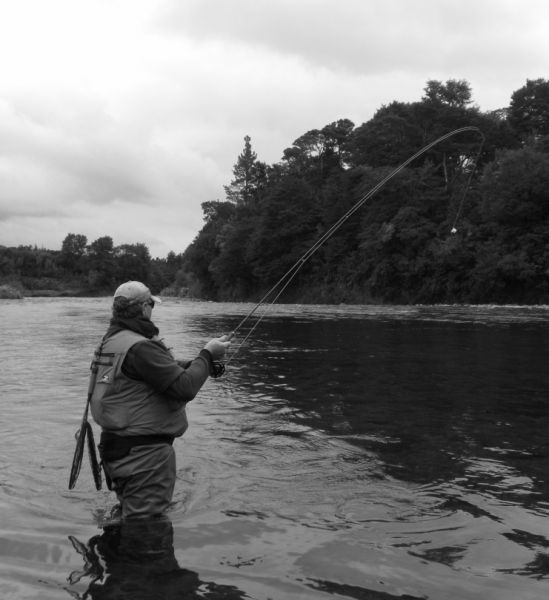 I don't miss much about the UK ... but one thing I do miss is the huge choice of fishing tackle available there. Trout fishing, sea fishing and coarse angling are all extremely popular pastimes in Britain and there is an endless supply of good quality equipment to cater for every branch of the sport. I don't miss much about the UK ... but one thing I do miss is the huge choice of fishing tackle available there. Trout fishing, sea fishing and coarse angling are all extremely popular pastimes in Britain and there is an endless supply of good quality equipment to cater for every branch of the sport.
But it isn’t only the big items. I'm a sucker for gadgets ... always have been. Pop into any U.K angling store and its like an Aladdin's cave with heaps of little bits and bobs that make make life easier for the fisho. Over there its known collectively as terminal tackle and it seems as if someone comes up with a new idea just about every week.
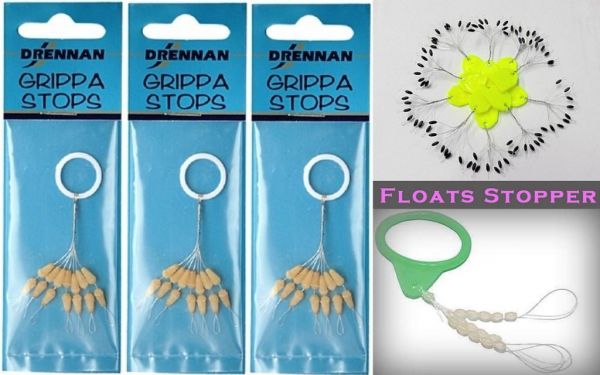
When Terry comes over he always brings a few packets of rubber float stops. Although I've never seen them in New Zealand they're in common use in many countries either as a single back stop i.e., for sliding floats or in pairs to hold "waggler" rigged floats in place.
I'd better explain a waggler is a float that's attached bottom end only ... a bit like our indicators ... you can see where I'm going with this. Although they grip the line firmly you can still move them, allowing you quick and easy depth adjustment. And best of all they come pre-loaded on wire loops ready for use.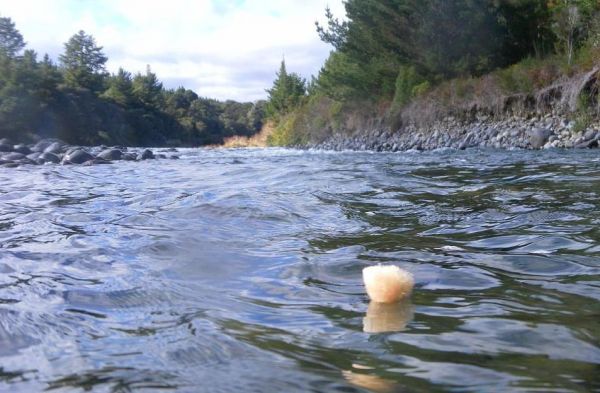 Everyone has a different way of attaching the indicator. But if you"re constantly on the move using one that slides on the line will be a huge advantage both when fishing and landing trout. Everyone has a different way of attaching the indicator. But if you"re constantly on the move using one that slides on the line will be a huge advantage both when fishing and landing trout.
There are a number of fixing methods that will allow the indicator to slide up and down, figure of eighting small pieces of rubber rig tube, tiny dental bands, slip knots, rig crimps etc.
But the advantage of float stops is they are custom made for the job and they don't damage or kink the line in any way.
The small ones can be used to lock the dry in position on a dry and dropper rig again giving you the option of instant depth adjustment.
The disadvantages ... as far as I know they are not in NZ yet and you can't easily re-use them.
Dozens of tackle manufacturers make them, Drennan, Fox, Shakespeare to name a few. So you could probably source them on Ebay or give Scotty a ring at Creel Tackle ... if enough people nag him he might order some in.
UPDATE:
Steve from Hutt Valley Hunting and Fishing says I should open my eyes when I'm in the shop because they have plenty.
The step by step below describes the way to make up a nymphing leader with a sliding indicator using float stoppers, others may do it differently. I like to use a fifteen to twenty pound butt, depending on conditions and the time of year, with a loop on one end and a small swivel on the other. The swivel serves as a connection point for the rest of the leader.
This thicker section carries the sliding indicator and I keep half a dozen already made up in a rig wallet. In winter I attach approximately eight feet of eight pound Maxima to this. This gives an overall leader length which can be adjusted from eight to thirteen feet. For the photographs I've used larger swivels than I would normally use.
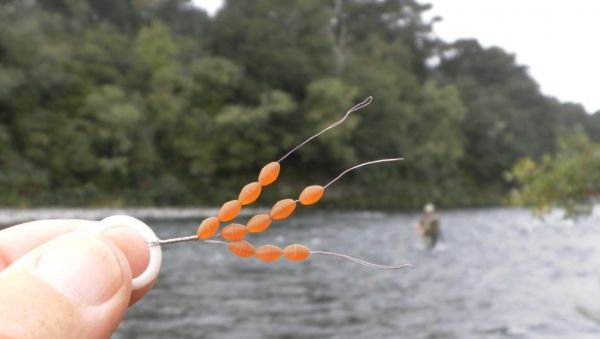 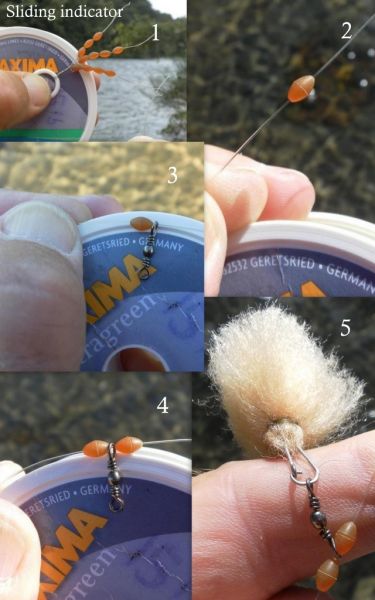
STEP 1
Pull off five and a half feet of 15 lb - 20 lb BS line and tie a loop in one end. Thread the other end through one of the wire loops and double about three inches of line back on itself.
STEP 2
Now slide a single rubber stop down the wire loop onto the doubled line taking it a couple of feet past the tag.
STEP 3
Thread on a small swivel and let it slip down to the stop.
STEP 4
Repeat step one and slide on another rubber stop. At this point I tie a second swivel to the end of the line. So you have a loop at one end and a swivel at the other.
STEP 5
Attach it loop to loop to your fly line, tie on the rest of the leader and flies, then clip on an indicator and go fishing.
A week or so back I was sent this very sad story.
"As a guitarist, I play a lot of gigs. Recently I was asked by a funeral director to play at a graveside service for a homeless man. He had no family or friends, so the service was to be at a pauper’s cemetery in the back country.
I wasn't familiar with this part of NZ and got lost. When I finally arrived I was over an hour late and saw the funeral guy had evidently gone and the hearse was nowhere in sight. There were only the diggers and crew left and they were eating lunch.
I felt really bad and apologized to the men for being late, then went to the side of the grave and looked down but the vault lid was already in place. I didn’t know what else to do, so I started to play.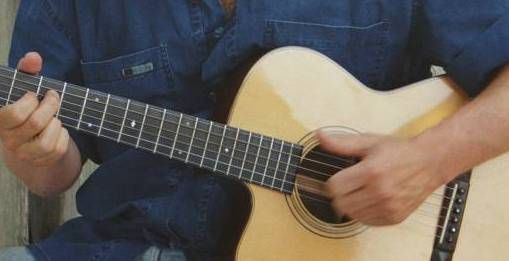 
The men put down their lunches and began to gather around as I played my heart and soul out for this poor man with no family or friends. In fact I played like I’ve never played before for this unfortunate person who had died all alone.
As I began to play ‘Amazing Grace,’ tears filled my eyes and the workers began to cry. They wept, I wept, we wept together. When I finished I packed up my guitar and started for my car. Though my head hung low, my heart was full.
As I walked past them, I heard one of the workers say, “ that was incredible Bro ... I never seen nothin’ like that before ... and I’ve been putting in septic tanks for twenty years.”
Apparently, I was still lost…"
SUMMARY
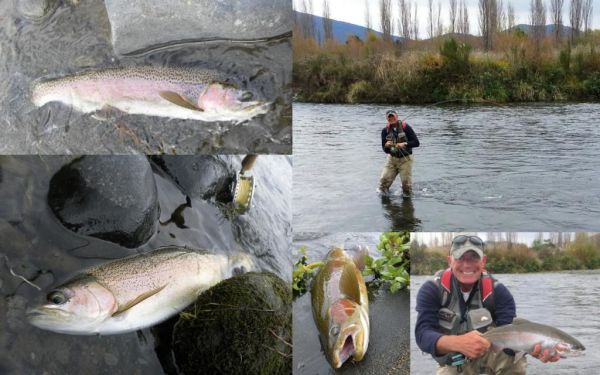
Bit of a mixed bag again this week. A few more recovering fish turning up in catches probably brought down with the mini fresh we had. I've seen a couple of anglers carrying browns and I caught my first ever trout with a harelip! You can see it in the collage bottom center.
Not too many freshies around but when you do hook one hang on tight. Mark took that pic above of me doing just that in the lower river.
The rain didn't last long but it was enough to knock back some of the algae growth and freshen the river up a bit. But there's still plenty left for the creepy crawlies and during the day there have been some good mayfly hatches.
Its early days and things are not pumping yet but keep on the move and you'll find a few fish.
Settled weather for the rest of the week and with angling pressure still light its a very pleasant time to be on the river at present ... but there is rain on the way.
MetService Updated Seasonal Weather Outlook for May and June 2013.
The pattern for the next several weeks looks like it will be a typical autumn to early winter scenario with active troughs interspersed with anticyclones but with a more active flavour compared to the March and early April. The track of the anticyclones will also be slightly further north as they move across New Zealand thus allowing southern areas to be more exposed to the roaring forties and associated weather systems they bring with them. Between these the anticyclones, troughs are forecast to move onto the country from the south and west, bringing further spells of rain to the West Coast of the South Island. Cold southerly changes will also become more notable up the east coast of the South Island in the wake of exiting weather systems.Overnight frosts, and perhaps even snow in some locations, will also be likely as we head further into May and June. With the more active weather pattern over the next several weeks the general forecast for the country is for rainfall figures to be about normal for the time of year while temperatures are likely to be average or just above. Keep an eye out for any periods of blocking. This can cause the weather patterns to get stuck in place and cause anomalies of wet or dry to take place.
Taumarunui, Taihape, Taranaki, Taupo
RAIN: Average
WIND: about normal.
TEMPERATURE: Average or above average
SUNSHINE: about normal.
SPECIALS: a changing pattern.
CONFIDENCE: moderate
The main pattern consists of a reasonably regular supply of fronts coming in from the Tasman Sea, each bringing a period of showers or maybe half-a-day of rain. These will also be interspersed with anticyclones but not as frequently as March/early April. Keep an eye on the weather maps for low-pressure systems that develop over the Tasman Sea - these are likely to bring you a significantly wet and windy period for a day or two.
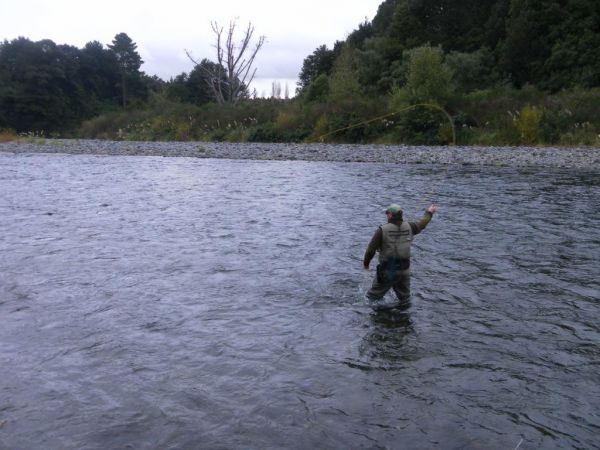
Tight lines guys
Mike |
|
|
| Back to Top |
|
|
|
|
|
|
|